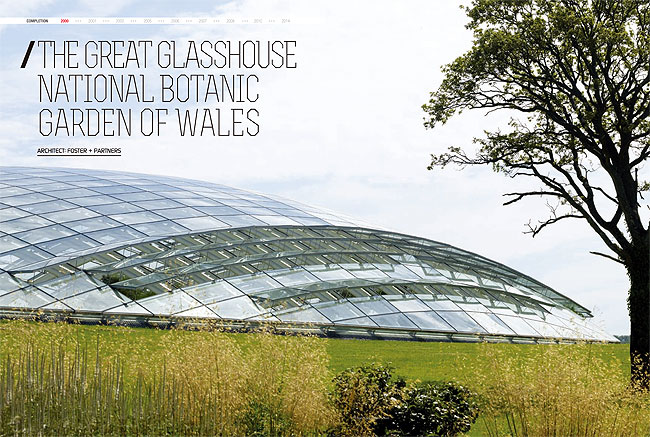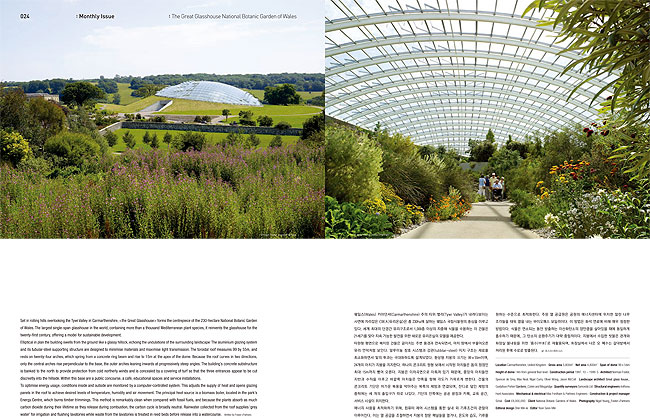Bombay Sapphire Distillery, Laverstoke Mill
Architect : Heatherwick studio



진(gin) 제조업체인 봄베이 사파이어(Bombay Sapphire)는 이 회사 최초의 사내 생산시설을 신축하는 프로젝트를 의뢰하였고, 이곳엔 일반 고객도 방문할 수 있다. 옛 수력발전 제지 공장이 있던 대지에는 역사적으로 중요한 노후 건물들이 40채 이상 남아 있었으며, 건축가의 마스터플랜을 통해 이런 건물들을 재생하고 복원하였다. 총괄 계획은 테스트 강(River Test)을 중심으로 개발되었는데, 이전까지 좁고 높은 콘크리트 수로에 갇혀 수년간 집중적 으로 개발된 주변 대지에 가려져 있던 강에 초점을 맞추었다. 테스트 강은 복잡한 대지와 그곳에 집적해온 시설들을 이해하는데 중요한 구성장치가 되었다. 이 강은 폭이 넓어지고 강둑도 외부로 개방되었으며, 식재를 심어 새로운 모습으로 변신했다. 강을 따라 걷는 방문객들은 역사적 건물들로 둘러싸인 중심의 새로 정의된 마당을 만나게 된다. 강물의 모습과 가치를 다시 드러내기 위해, 강의 폭은 원래의 두 배 이상으로 넓어졌고 강둑은 물가에 심은 식물과 함께 새로운 모습으로 변했다. 본래의 프로젝트 요강에는 별도의 방문객 센터가 포함되어 있었지만, 설계팀은 불필요하다고 생각했다. 오히려 대중이 증류 과정을 더 가까이서 관찰하고, 조각적인 동판 진 증류기들을 보며 더욱 실감나는 경험을 하는 게 좋다고 판단했다. 따라서 우리는 총괄 계획으로 봄베이 사파이어 증류과정에 사용되는 10종의 외래 식물을 재배할 두 채의 유리온실 신축을 제안했다. 한 곳에는 습한 열대 환경을 조성하고, 다른 한 곳에는 건조하고 온난한 지중해 기후를 조성하여 북쪽의 증류소에서 뻗어 나와 폭을 넓힌 강물 속에 자리를 잡았다. 증류소와 연결되면서, 증류 과정에서 생긴 폐열은 식물들이 번성하기 좋은 따뜻한 기후를 유지하는 데 재활용된다. 신축 유리 온실들의 유동적 형상은 최근 유리 기술의 발전과 영국에서 발달한 유리구조 식물원의 풍부한 유산에서 영향을 받았다. 이 새로운 식물원 유형의 증류소는 영국 친환경평가기준인 브리암(BREEAM)의 지속가능성 평가에서 ‘우수(outstanding)’ 등급을 획득했으며, 주류 제조업 시설 가운데 이런 등급을 획득한 경우는 이 건물이 처음이다
글: 헤더윅 스튜디오
The gin-maker Bombay Sapphire commissioned the creation of the company’s first in-house production facility, which will also be open for members of the public to visit. Formerly a waterpowered paper mill, the site contained more than forty derelict buildings, many of historical significance, which have been regenerated and restored as part of our master plan. Central to the development of the master plan is the River Test, which was previously almost invisible, contained within a narrow high-sided concrete channel and largely covered over as the site had intensively developed over many years. The river became the central organizing device to make sense of the complex site and this accumulation of facilities. The river has been widened and its banks opened out and planted in order to transform it into a route that draws visitors through the site to a newly defined courtyard at its centre, surrounded by historic buildings. To make the water visible and valuable once more the river has taken on more than twice its original width and its banks reshaped with planted foreshores. The original project brief included provision of a separate visitor centre. However the design team believed this not to be necessary, preferring to allow the public a more authentic experience by getting closer to the distillation process and seeing the sculptural copper gin stills in use. Our master plan proposed the creation of two new glasshouses to grow specimens of the 10 exotic plant species used in the Bombay Sapphire distillation process. These glasshouses, one of them containing a humid tropical environment and the other a dry temperate Mediterranean climate, emerge from the northern still house to sit within the waters of the widened river. The connection to the still house allows waste heat from the distillation process to be recycled to maintain the warm climates for the plant species to flourish. The fluid geometry of these new glass buildings was influenced by recent advances in glass technology and by Britain’s rich heritage of botanical glasshouse structures. This new botanical distillery has achieved a BREEAM ‘Outstanding’ rating for sustainability; the first facility in the drinks manufacturing industry to be awarded this rating.
Written by Heatherwick studio
건축문화 2016년 3월호 [Monthly Issue]페이지 © 에이엔씨출판(주)